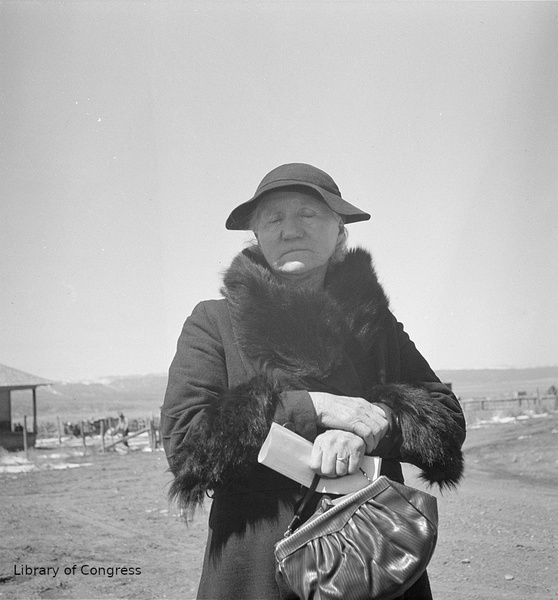Dublin Core
Title
Putting a Face on Poverty: Dorothea Lange in Utah
Description
Famous photographer Dorothea Lange captured the heartbreaking struggles and resiliency of rural Utah during the Great Depression. Find out more about Lange and her extraordinary photographs.
During the Great Depression of the early 1930s, Utah experienced severe drought and economic hardship, and was, in fact, the top recipient of federal relief dollars. In one project of the era, the federal Farm Security Administration sent a team of photographers around the country to document communities hit hardest by the Depression. Dorothea Lange, a photojournalist from New Jersey known for capturing some of the most famous photographs in American history, was sent to rural Utah. Lange felt a responsibility to capture matter-of-fact images of her subjects and their lives. In doing so, she gave a human face to rural poverty and the devastation wrought by the Great Depression.
Lange first went to company towns owned by Blue Blaze Coal in Carbon County. In one image, a single coal miner stares confidently into the camera, holding his lunch bucket in front of a rail car. In another, a mother scrambles through the snow with her young children. Despite their economic uncertainty and poor living conditions, miners and their families appear strong and proud in the face of struggle. In the Garfield County towns of Widtsoe and Escalante, Lange photographed Mormon farmers, their land, buildings, and families. In one photograph taken there, a woman -- wrapped in an elegant fur-trimmed coat with a large hat casting her somber face in shadow -- receives her old-age assistance check for the first time.
In each of these photographs, Lange captured the enduring dignity of men and women surviving life amid crisis. More than an artist or photographer, Lange felt throughout her career that she was an activist, responsible for showing the reality of life for average Americans. During the Second World War, she photographed Japanese-American incarceration camps for the War Relocation Authority. Her images were suppressed, however, because of their clear criticism of citizen internment and her ability to humanize the people she photographed.
Lange saw her work as a force for change and often blurred the lines between journalism, art, and activism. More than just artwork or pieces of history, Lange’s photographs give a precious glimpse into rural Utah during the Great Depression that still speak to us today.
During the Great Depression of the early 1930s, Utah experienced severe drought and economic hardship, and was, in fact, the top recipient of federal relief dollars. In one project of the era, the federal Farm Security Administration sent a team of photographers around the country to document communities hit hardest by the Depression. Dorothea Lange, a photojournalist from New Jersey known for capturing some of the most famous photographs in American history, was sent to rural Utah. Lange felt a responsibility to capture matter-of-fact images of her subjects and their lives. In doing so, she gave a human face to rural poverty and the devastation wrought by the Great Depression.
Lange first went to company towns owned by Blue Blaze Coal in Carbon County. In one image, a single coal miner stares confidently into the camera, holding his lunch bucket in front of a rail car. In another, a mother scrambles through the snow with her young children. Despite their economic uncertainty and poor living conditions, miners and their families appear strong and proud in the face of struggle. In the Garfield County towns of Widtsoe and Escalante, Lange photographed Mormon farmers, their land, buildings, and families. In one photograph taken there, a woman -- wrapped in an elegant fur-trimmed coat with a large hat casting her somber face in shadow -- receives her old-age assistance check for the first time.
In each of these photographs, Lange captured the enduring dignity of men and women surviving life amid crisis. More than an artist or photographer, Lange felt throughout her career that she was an activist, responsible for showing the reality of life for average Americans. During the Second World War, she photographed Japanese-American incarceration camps for the War Relocation Authority. Her images were suppressed, however, because of their clear criticism of citizen internment and her ability to humanize the people she photographed.
Lange saw her work as a force for change and often blurred the lines between journalism, art, and activism. More than just artwork or pieces of history, Lange’s photographs give a precious glimpse into rural Utah during the Great Depression that still speak to us today.
Creator
By Megan Weiss for Utah Humanities © 2023
Source
Image: Mormon woman and native of Denmark receiving her old age assistance check for the first time, Widtsoe, Utah, 1936. Photo by Dorothea Lange. Image courtesy of Library of Congress, Prints & Photographs Division, Farm Security Administration/Office of War Information Black-and-White Negatives.
_______________
See James R. Swensen, “Dorothea Lange’s Portrait of Utah’s Great Depression,” Utah Historical Quarterly 70 (2002); Jorge Iber, Hispanics in the Mormon Zion, 1912-1999 (Texas A&M University Press, 2000); Wayne K. Hinton, “The Economics of Ambivalence: Utah's Depression Experience,” Utah Historical Quarterly 54 (1986); Natalie Dupêcher, “Bad as it is, the world is potentially full of good photographs. But to be good, photographs have to be full of the world: Dorothea Lange and Daniel Dixon,” The Museum of Modern Art, accessed September 2023.
_______________
See James R. Swensen, “Dorothea Lange’s Portrait of Utah’s Great Depression,” Utah Historical Quarterly 70 (2002); Jorge Iber, Hispanics in the Mormon Zion, 1912-1999 (Texas A&M University Press, 2000); Wayne K. Hinton, “The Economics of Ambivalence: Utah's Depression Experience,” Utah Historical Quarterly 54 (1986); Natalie Dupêcher, “Bad as it is, the world is potentially full of good photographs. But to be good, photographs have to be full of the world: Dorothea Lange and Daniel Dixon,” The Museum of Modern Art, accessed September 2023.
Publisher
The Beehive Archive is a production of Utah Humanities. Find sources and the whole collection of past episodes at www.utahhumanities.org/stories.
Date
2023-10-13

